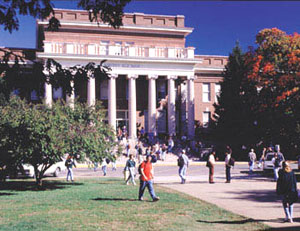
Middle Tennessee State University
Located in Murfreesboro, Middle Tennessee State University was created by the General Education Bill of 1909 and dedicated on September 11, 1911, as Middle Tennessee State Normal School. Many local residents joined President Robert L. Jones, the faculty, staff, and state officials in the dedication day’s celebration. Murfreesboro leaders and businessmen, especially Andrew L. Todd, a member of the State Board of Education, had lobbied to locate the new state teacher’s college for Middle Tennessee in Murfreesboro. They donated land and pledged $180,000 to see the campus and its buildings completed. Acquiring the new higher education institution proved to be worth the sacrifice. Together with the recently established Tennessee College for Women, the normal school, later a college and then a university, would have an enormous influence on the twentieth-century development of Murfreesboro and the surrounding counties.
The original campus had one hundred acres, five buildings, and 125 students. Nashville architect C. K. Colley designed the school’s buildings in a dignified Classical Revival style and today the President’s House, Kirksey Old Main, Rutledge Hall, and the Alumni Center still form the historic core of the campus. The first men’s dorm, Jones Hall, was constructed in a compatible Classical Revival style in 1922.
In 1925 the normal school became Middle Tennessee State Teachers College, a four-year institution with the power to grant a Bachelor of Science degree. Due to increased state funding for higher education during the administration of Austin Peay, the college gained a new library, science building (Wiser-Patten Hall), a teacher’s training school (Pittard Campus School), and additional dormitories. It received accreditation from the Southern Association of Colleges and Schools in 1928.
Despite the new buildings, the Great Depression brought uncertainty to the college. Murfreesboro resident Mabel Pittard recalled: “[T]hey talked about closing down the school. There was an undercurrent of not knowing what was going to happen.” (1) New Deal agencies helped the students, and college, stay afloat during the cash-strapped times. The National Youth Administration provided scholarships and funds so students could work and stay in school. The Works Progress Administration undertook other projects and improved the campus’s landscaping. The school introduced the Bachelor of Arts degree in 1936.
In 1943 officials changed the college’s name to Middle Tennessee State College. Student enrollment, however, remained depressed until the end of World War II, when returning veterans took advantage of the GI Bill and entered the institution in record numbers. Under the presidency of Quintin M. Smith, the institution developed a new identity and mission in education, liberal arts, and the sciences. It established a Graduate School in 1951. Fifteen new major buildings were constructed from 1951 to 1964 to provide additional classrooms, dorms, recreation, and a modern library. When state officials and President Quill Cope, a former State Commissioner of Education, dedicated the new Cope Administration Building in 1965, the college had firmly entered its modern era, and it officially received the designation of university.
As Middle Tennessee State University, the institution experienced a period of rapid expansion in student numbers, faculty size, and facilities during the presidency of M. G. Scarlett in the late 1960s and early 1970s. Peck Hall, a liberal arts classroom building; Keathley University Center; Davis Science Building; Murphy Athletic Center; a library expansion; and the McWherter Learning Resources Center were constructed between 1967 and 1975. The university also added the degrees of Doctor of Art in 1970 and Specialist in Education in 1974.
Growth of MTSU’s facilities slowed over the next ten years, due in part to federal court decisions regarding the integration of student bodies and faculties at MTSU and Tennessee State University in Nashville. Yet, during the 1980s administration of President Sam Ingram, student enrollment continued to expand, exceeding 11,000 in 1980, and the university developed nationally recognized programs in aerospace, mass communications, historic preservation, and recording industry management. In 1984 Governor Lamar Alexander’s program to improve Tennessee higher education led to the creation of the Center for Historic Preservation; a year later came the Center for Popular Music. By the end of the decade, the Bragg Mass Communications Building was under construction, signaling a new era of university expansion.
The 1990s witnessed dramatic growth in students, programs, and facilities at MTSU. Along with its two centers of excellence in historic preservation and popular music, the university has eight chairs of excellence. The Business and Economic Research Center has assisted economic planning and development statewide while the Albert Gore Sr. Research Center has evolved into an important archive for twentieth-century American political history. New buildings include the Cason-Kennedy Nursing Center, the Miller Equine Center and Arena, a football stadium seating over thirty thousand, the Business Aerospace Building, a new library, and a modern campus recreation center. This transformation of the university’s facilities and related programs came under the leadership of President James Walker, the first African American president of a formerly all-white state university. Walker resigned from the presidency in 2000.
By the fall of 2000, MTSU had grown into the second largest public university in Tennessee, with its FTE (full time equivalent) enrollment reaching 16,339 out of a total headcount enrollment of 19,121. A new, part-time addition to the faculty was former Vice-President Albert Gore Jr., who taught a special Community Building class at the university in the spring 2001 semester.



